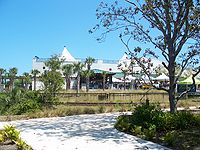St. Augustine Amphitheatre
 Panorama view of the amphitheatre | |
 | |
| Address | 1340 A1A S # C St Augustine, Florida United States |
|---|---|
| Owner | St. Johns County Parks & Recreation department[1] |
| Capacity | 3493[2] |
| Construction | |
| Opened | 1965[2][3][4] |
| Rebuilt | 2001 - 2007, Fred Halback and Les Thomas[5][6] |
| Years active | 1965 - present |
| Website | |
| http://www.staugamphitheatre.com/ | |
The St. Augustine is a venue for outdoor concerts and other large gatherings in St Augustine, Florida, United States. The Amphitheatre seats 3,493 persons, and is managed by the St. Johns County Parks & Recreation department.
History
The Amphitheatre was built in 1965 to commemorate the 400th anniversary of the founding of St. Augustine.[2][3][4] The land was originally part of Anastasia State Park.[1] The amphitheatre itself was constructed in one of the old coquina quarries used to supply building materials for St. Augustine and the Castillo de San Marcos.[7][8][9]
The Pulitzer Prize winning playwright Paul Green was commissioned to write a play to be performed at the Amphitheatre. The result was Cross and Sword: A Symphonic Drama of the Spanish Settlement of Florida,[10] a musical reenactment of the first years of St. Augustine's existence. It was designated the official state play in 1973 by the Florida Legislature.[11] The play ran until 1996, when budget constraints ended its more than 30 year run.[3][4][12]
The amphitheatre was used infrequently during the following years, though it did host a free summer Shakespeare Festival from 1997 to 2003.[13][14] In 2002, St. Johns County acquired the property and the following year began an 8.7 million dollar renovation.[3][4] The upgraded facility reopened in August 2007, which includes a fiberglass tensile canopy over the main stage.[15]
References
- ^ a b everything old is new again - the new history of the st. augustine amphitheatre jon bosworth
- ^ a b c St. Augustine Amphitheatre - Venue - Specs
- ^ a b c d Amped at the amphitheatre Rick de Yampert
- ^ a b c d St. Augustine gets amped Amy Reinink
- ^ St. Augustine Amphitheatre - Halback Design Group, Inc.
- ^ Editorial: St. Augustine Amphitheatre plans reflect labor of love
- ^ Birding Florida Brian Rapoza, page 31
- ^ The Book Lover's Guide to Florida Kevin M. McCarthy, page 79
- ^ Quarry Historical Site - Anastasia State Park
- ^ Paul Green Bibliography
- ^ Florida State Symbols - The State Play: Cross and Sword
- ^ A Guide to Historic St. Augustine, Florida Steve Rajtar, Kelly Goodman, page 53
- ^ Art thou ready for 'Much Ado About Nothing'?
- ^ Atlantic Shakespeare Company to present musical fund-raiser
- ^ St. Augustine Amphitheatre - St. Johns County Government Gateway
